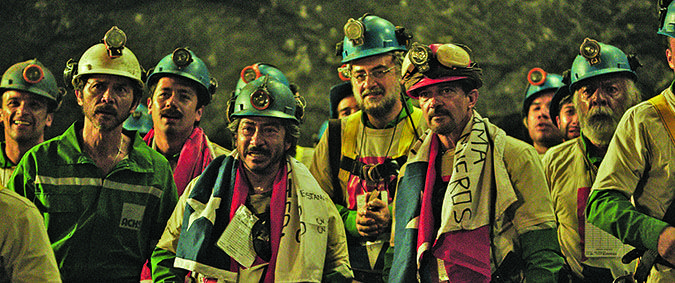In a moment of utter hopelessness, a young man sits alone, lost and dejected.
An older, wiser acquaintance — known affectionately as “the pastor” — approaches the younger man and reaches out to him, attempting to quell his pain and turmoil.
“We can say a prayer together,” suggests the pastor. “I don’t know the words,” replies the younger man.“God doesn’t care,” he responds with confidence.
This touching exchange is one of several faith-filled messages scattered throughout the newly released “The 33,” a spiritually uplifting and emotionally captivating film based on the harrowing and incredible real-life tale of 33 men who were trapped 2,300 feet underground for 69 days after the catastrophic collapse of a century-old gold and copper mine in the Atacama region of Chile in 2010.
Produced by Warner Bros. Pictures and Alcon Entertainment, “The 33” is being released on Nov. 13 — exactly five years and one month after the first of the 33 trapped miners finally resurfaced following an international rescue effort.
The film begins one day before the Aug. 5 collapse in 2010, which left the miners virtually buried alive with minimal food and water, and very little realistic hope for survival.
More than two weeks later, rescue drillers finally made initial contact with the miners. As extensive drilling efforts continued for 52 more days — to ensure the creation of a safe exit pathway for the group — the trapped men were saved from starvation when rescuers began transporting food underground via a narrow tube.
In the aftermath of their eventual rescue, most of the miners revealed that they relied heavily on prayer, their faith in God, and mutual support in their moments of darkest despair to help keep them alive — moments dramatized poignantly and beautifully in various scenes.
Though not religious per se, the movie does not shy away from depicting religious symbolism and faith in its various forms, both within the mine and above ground, where family and friends remained encamped for months, holding frequent prayer vigils surrounded by photos of their loved ones, statues of Mary and other religious icons, and countless Chilean flags.
“This movie is about being trapped and alone and facing death, but it is equally about having faith and, in a way, coming back to life,” stated the director Patricia Riggen. “It’s about rebirth and the strength of the human spirit and so much more.”
As the miners began to emerge from the darkness of the underground mine one by one in the early hours of Oct. 13 — via the Phoenix II, a narrow NASA-designed capsule — hundreds of family members were impatiently awaiting their return, along with an estimated 2,000 media professionals from around the world who were on hand to capture every moment of the historic rescue operation.
The unbelievable story of survival captured international attention. The Chilean government provided exclusive non-stop television coverage, making the rescue among the most-watched video streams of all time. Chile’s state broadcaster TVN reported that over one billion people watched the rescue on TV across the globe.
The film convincingly presents key elements of the true story, from the mine collapse itself, to the enormity and improbability of successfully undertaking a rescue of this magnitude, all complemented by a visually stunning backdrop.
Despite the introduction of several seemingly main protagonists, some early character development seems prematurely stunted midway through, as the film shifts to focus on fewer individual stories and essentially sidelines the rest.
Despite such weakness — including what some might view as heart-tugging plot devices — the film nonetheless succeeds in capturing the triumph of the human spirit a la “Rocky,” while celebrating the power of love and the importance of faith. Though we know the ending, “The 33” will still make you want to cry and cheer.
Rated PG-13, “The 33” stars Antonio Banderas, Lou Diamond Phillips, Kate del Castillo, Chilean-born actress and singer Cote de Pablo, and Academy Award-winner Juliette Binoche.

